As the fine wine industry starts preparing for another Bordeaux en primeur season at a distance, Wine Lister has published Part I of its annual in-depth Bordeaux Study. With insights from key fine wine trade players from across the globe, Part I evaluates Bordeaux’s recent performance, considers the major takeaways from the 2019 vintage campaign, and contemplates the lessons they might provide moving forwards.
Please see our key findings below:
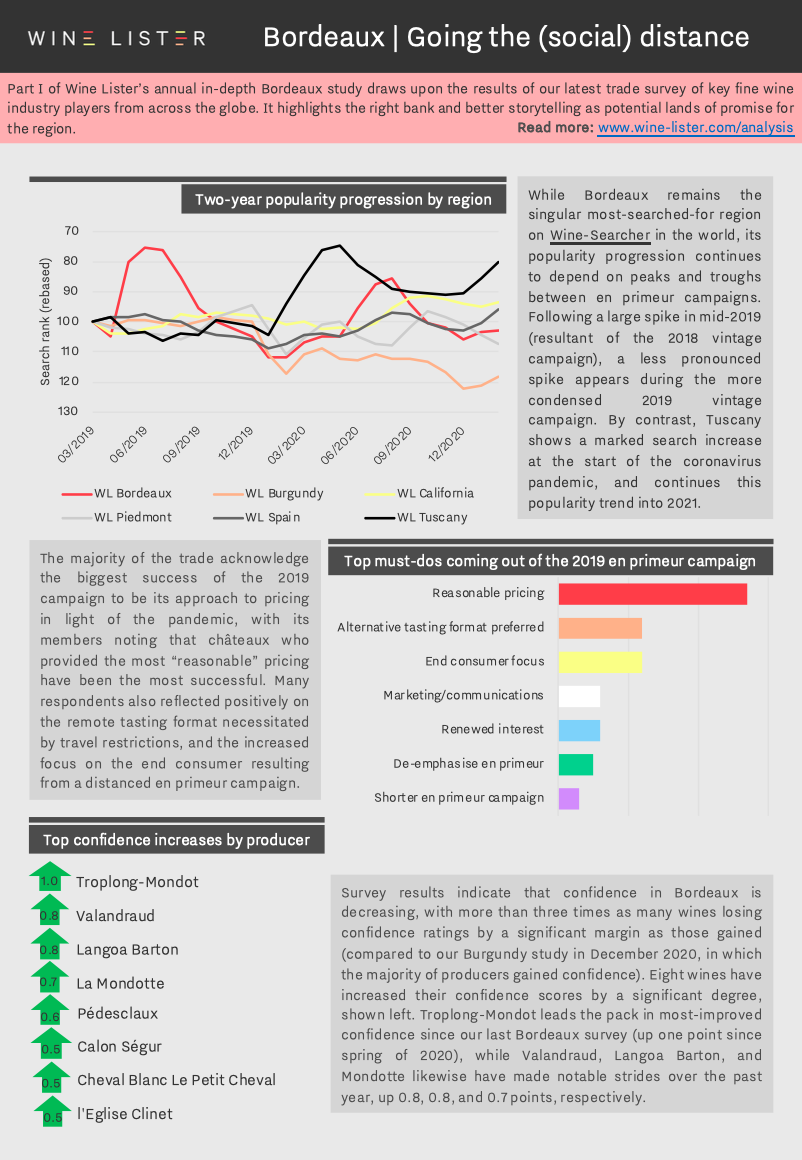
You can download the study digest in English here: Wine Lister 2021 Bordeaux Study – Digest or French here: Wine Lister 2021 Bordeaux Résumé d’étude. The full report can be purchased on our Analysis page, while Pro subscribers can access their free copy here.
With Bordeaux 2020 en primeur fast approaching, Wine Lister reports on one of the latest updates to emerge from the Médoc, informing your investment decisions over the coming months. In collaboration with Château Lafon-Rochet, we speak to Basile Tesseron to find out more about the inaugural partnership of two of the most revered consultants in Bordeaux to work on the estate’s 2020 blend: Jean-Claude Berrouet and Eric Boissenot.

Renowned for his expertise in Merlot production at Pomerol’s Château Petrus, Lafon-Rochet’s existing consultant, Jean-Claude Berrouet has been working at the estate alongside his son, Jeff, since 2012. Basile tells us that his team “admire the quality of the tannins present in the wines that Jean-Claude consults on, as well as his expertise with grapes coming from clay soils”.
With almost half of the estate based on clay, and the other half on dry, deep, gravely soils, he explains that “it was logical to combine Jean-Claude’s work with that of Eric Boissenot”, whose father, Jacques, has also been working with Lafon-Rochet for several years. With a reputation as oenologist to some of the Médoc’s top châteaux, Eric Boissenot is known for his dedication to the accentuation of terroir.
This meeting of minds from the Right and Left Banks for the first time illustrates another step in the evolution of Lafon-Rochet under Basile’s guidance. Since taking over the running of the estate in 2007, he has overseen the construction of two new cellars, extensive replanting, and a dedicated biodiversity programme. Having spent several years conducting agroforestry trials, last year Lafon-Rochet embarked on an agroforestry scheme that aims to make the estate wild once again through assisted natural regeneration. As well as installing bat nesting boxes and beehives, the property aims to plant 13,000 trees on its land by 2022.
Click here to sign up to Wine Lister’s free newsletter to keep track of everything en primeur over the coming months, including our recommendations on which releases to buy.
WL PR offers a dedicated communications service to help fine wine producers tell their story within the UK market. Head to our services page here to find out more.
Like many of the world’s winemaking regions, Barolo is increasingly subject to dramatic weather patterns as a result of global warming. With significant frost in spring followed by an extremely hot summer, its 2017 growing season was no exception to these severe shifts. Akin to its vines, Barolo’s producers are now more than ever demonstrating their resilience to change, as evident in its latest offerings.
To guide those buying Barolo 2017 over the coming weeks, Wine Lister has spoken to nine of the region’s top producers to get a better picture of the vintage and its viticultural demands.
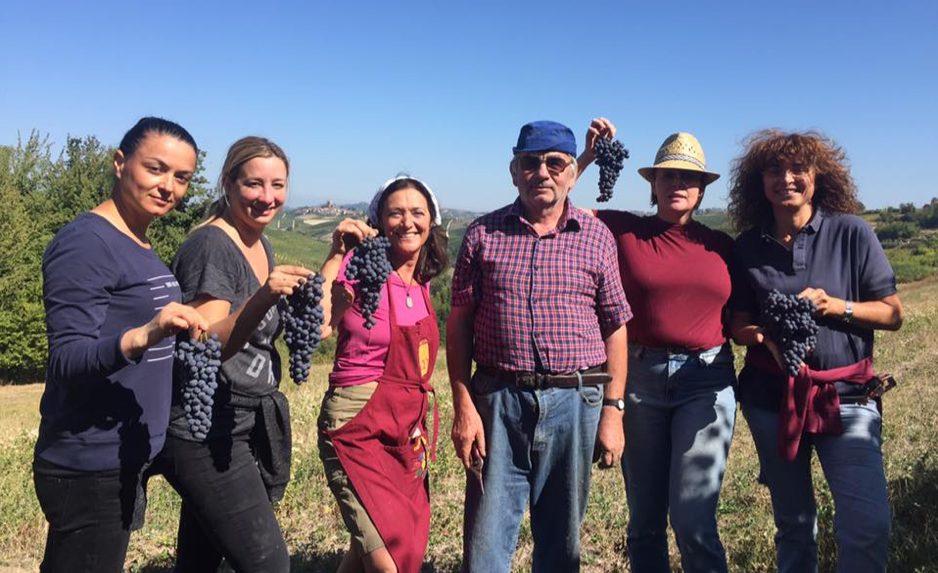 Chiara Boschis and her team during the 2017 harvest at E.Pira e Figli
Chiara Boschis and her team during the 2017 harvest at E.Pira e Figli
A reduction in production
As cited by several producers, spring frost and summer drought resulted in reduced yields across the board in 2017. Situated in the heart of Barolo, Chiara Boschis tells us that production at E.Pira e Figli was down between 10-20% on the 2016. The estate had to carefully select “clusters that were compact when picked”, as heat stress was preventing complete berry development. Marco Marengo notes that yields at his estate were 25% lower than average in 2017, while owner and winemaker at La Spinetta, Giorgio Rivetti, saw levels down by roughly 30%. A representative at Giacomo Conterno, Stephanie Flou tells us that its 2017 vintage was particularly affected by it being “the second year in a row in which [the estate] has suffered drought”. She states that while yields were limited “because the grapes dried out”, they are “positively surprised with how the vintage has ended up”.
Finding shade from the sun
Numerous estates noted the need for rigorous canopy management in 2017 – one of many adjustments applied across the region to cope with the extreme heat. Elio Altare’s second-generation winemaker, Silvia Altare tells us that hydric stress forced her to be amongst the vines, “meticulously managing the canopies to protect the grapes from the sun”. The team at Cantina Cooperativa Terre del Barolo also explain that this “was key in 2017 in order to keep bunches in shade, without suffocating them”, while “conservation tillage – mulching or grass covering in between the rows –was crucial to limit evaporation, and to protect the vines from the ‘mirror effect’ of the soil”. Vietti’s winemaker, Luca Currado notes that he similarly used “uniform, dense foliage to provide clusters with greater shade” and “grass cover between the rows to prevent sunlight reflecting directly onto the clusters”. The estate also started harvest significantly earlier than usual in 2017 – another recurring theme across the properties.
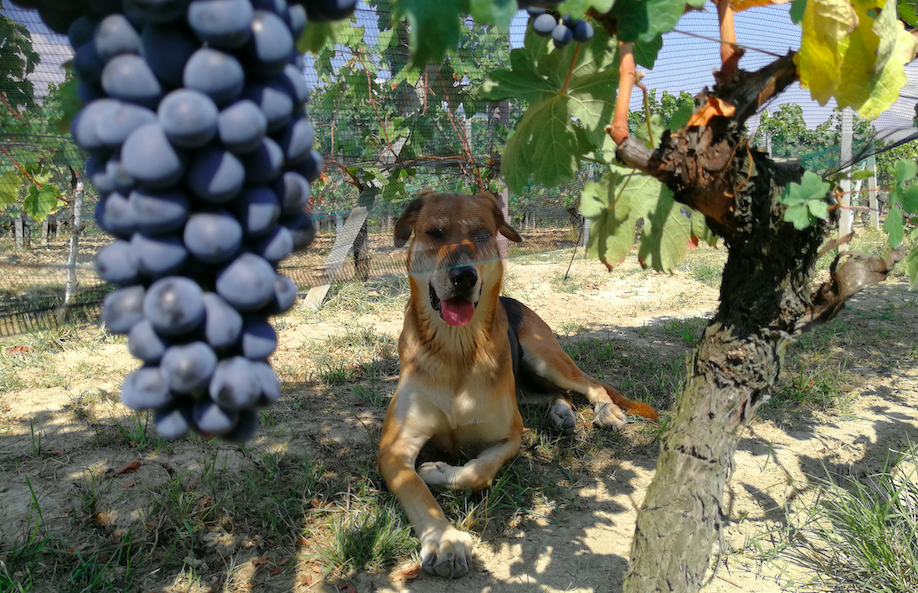 Keeping cool: the family dog at Elio Altare finds shade under the vines during the estate’s 2017 harvest
Keeping cool: the family dog at Elio Altare finds shade under the vines during the estate’s 2017 harvest
A crucial cooling
As mentioned by several of his peers, Azelia’s fifth-generation winemaker, Lorenzo Scavino tells us that a large diurnal temperature range helped to “preserve the freshness and the aromas of the grapes” in such a hot year. He states that while these cool nights “usually do not occur in warmer vintages, they were really a blessing”. Poderi Luigi Einaudi’s team echoed this sentiment, add that the temperature changes between day and night helped to develop the “polyphenolic profile of the Nebbiolo”, allowing “an excellent accumulation of tannins”. Rainfall in early September also helped to ensure balance in the 2017 vintage, with Luca Currado informing us that Vietti’s “Nebbiolo and Barbera benefited in particular, with highly complex polyphenolic profiles compared to other particularly rich vintages”, and “an unexpected freshness on the palate”.
The final freshness
Indeed, according to Wine Lister’s discussions with producers, freshness has been the great surprise of the 2017 vintage – a description applied repeatedly by Wine Lister’s partner critic, Antonio Galloni, in his notes on the region’s latest offerings. Chiara Boschis notes that E. Pira e Figli’s 2017 is “generous but very fresh”, while Azelia’s Lorenzo Scavino explains that rigorous vineyard management allowed them to “preserve the acidity, which is why even in this vintage we can find a great freshness”. Silvia Altare also tells us that while “2017 is definitely a warmer, more open knit vintage than 2016”, she has “noticed over the past few months the wines have integrated more and there’s a bit more freshness”.
The successful conception of balance in a year defined by drought aptly illustrates the resilience of Barolo’s producers in 2017, which may well be described as a winemaker’s vintage. Barolo 2017 scores have so far been high across the board, giving further merit to those who have created a wine of complexity and quality in a year of climatic uncertainty.
Keep track of new Barolo 2017 scores from Wine Lister’s partner critics here.
On 11th February, Sassicaia 2018 was released at £150 per bottle (in-bond), 6% up on the release price of the 2017.
Wine Lister attended an online tasting of this new release, as well as Guidalberto and Le Difese 2019, hosted by Armit Wines and Sassicaia’s third-generation director, Priscilla Incisa della Rocchetta. Armit’s Managing Director, Brett Fleming noted the uptake on all three wines has been excellent: “it has been an extremely successful launch from Tenuta San Guido over the past two weeks. Update and demand have been far in excess of anything we’ve been able to manage”.
Though all three wines are made in the large majority from international grape varieties, Priscilla’s observation that “Cabernet [has] found its sense of place in Bolgheri” shines through the wines. Each has its own distinct character, but with a fundamentally Tuscan undertone.
Background
Sassicaia began as the passion project of Marchese Mario Incisa della Rocchetta. While studying agriculture at the university of Pisa, he developed a penchant for wine from Cabernet vines, and subsequently invested in his own, so as to have wine for his family and friends that appealed to his tastes.
During the Zoom tasting, Priscilla told us that in the 1960s, Marchese Mario’s third son, (and Priscilla’s father) Marchese Nicoló, managed to convince him to begin distributing the wine, “transforming his hobby into something resembling a business”. Over the last half-century, the agricultural focus of Sassicaia’s 2,500-hectare estate has shifted increasingly towards top-quality winemaking. Still continued today nonetheless is the breeding of race-horses on the estate, as well as the preservation of a 500-hectare wildlife reserve.
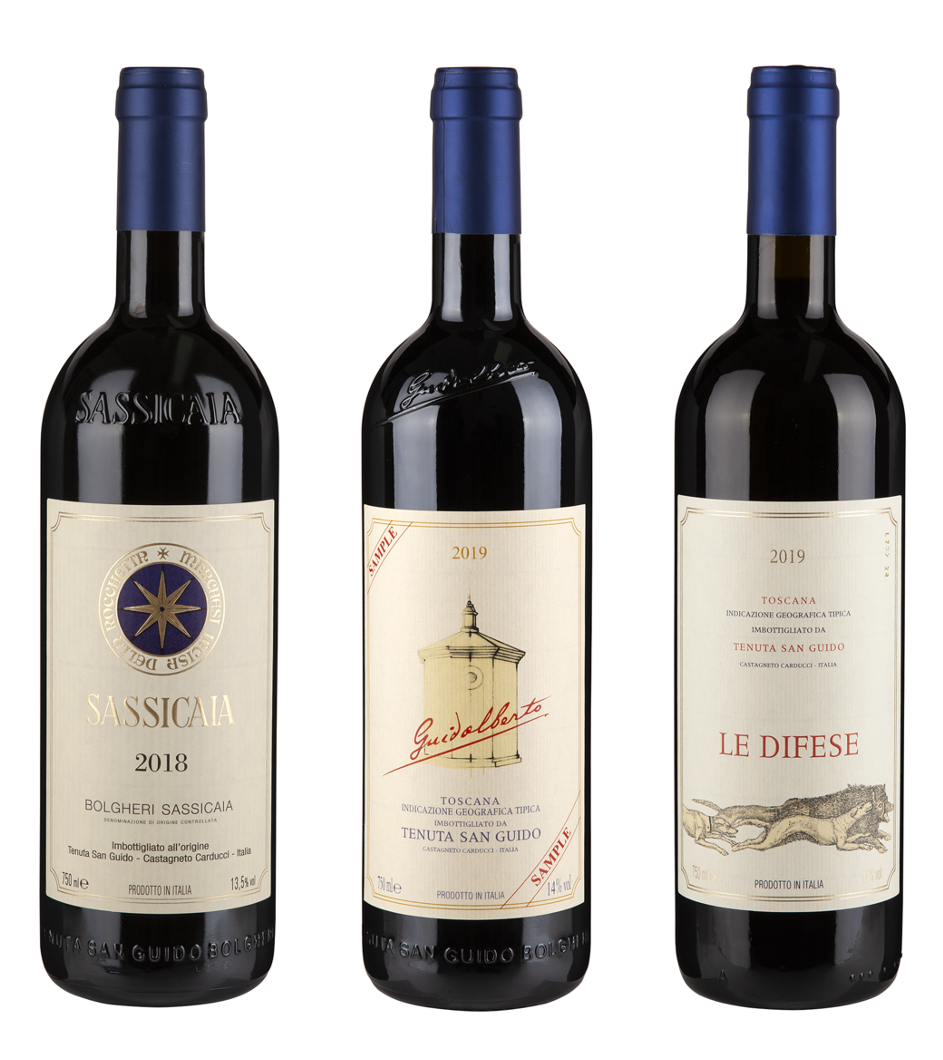 Official photos courtesy of Tenuta San Guido
Official photos courtesy of Tenuta San Guido
Sassicaia 2018
This is the 50th vintage of Sassicaia to be released onto the global wine market. Priscilla notes that “8” is usually a lucky number, and this was the case once again for the growing season resulting in this year’s anniversary release.
The wine leaps from the glass, with an energetic nose featuring suave red fruit, and a floral note of cherry blossom. The palate shows great depth – red cherries and plums as well as an earthier undertone, matched with a fine, elegant texture, particularly lifted by the wine’s vibrant acidity.
Guidalberto 2019
The only wine of the three tasted from a cask sample, the latest release from Guidalberto shows a sultry wine with impressive structure, yet seamless integration of its elements. The fruit profile is darker than its big cousin, but the same lift and freshness resounds on the palate, giving the wine a round and long finish.
Priscilla explains that the 2019 vintage was “warmer than other preceding vintages, not as much as 2017 or 2012, but comparable with 2009”. She continues, “we had a dry and mild winter, cool and rainy spring, but a regular summer, apart from rain during the middle of August which brought fresh air that allowed grapes to stay longer on the vines”. This small interruption to the ripening gave the Merlot a little extra time to soften.
She shares with us during the tasting the big news for Guidalberto – after postponing building plans for a brand new cellar of its own due to Covid restrictions, the works are finally underway, and the wine is set to have its own home, completely separate from Sassicaia, by 2023.
Le Difese 2019
After nearly 20 years in production (its first vintage was 2002), Le Difese proves itself a vibrant and well-balanced drinking wine. The 2019 shows an intense and immediate nose of sour cherry, and pure, juicy red berries on the palate.
Priscilla comments on its design; “[It] should be a wine that’s easy to drink, enjoyable young, aromatic but with some good structure because of the Cabernet Sauvignon”. The winemaking team has chosen to increase the amount of Sangiovese in the blend of the 2019 (from 30% up to 45%), so as to better service market demand for an easy-drinking wine that is approachable younger.
Over two years ago, Wine Lister published a blog on Tuscany’s 2018 vintage (recap here), which has since become the second most-read article on our site. With several 2018s entering the market over the past six months, and more scheduled for release this year, news of the vintage remains relevant.
To complete the picture first painted in our report on the 2018 harvest, we examine how some of the wines discussed have performed so far, and whether predictions on the vintage have come to fruition.
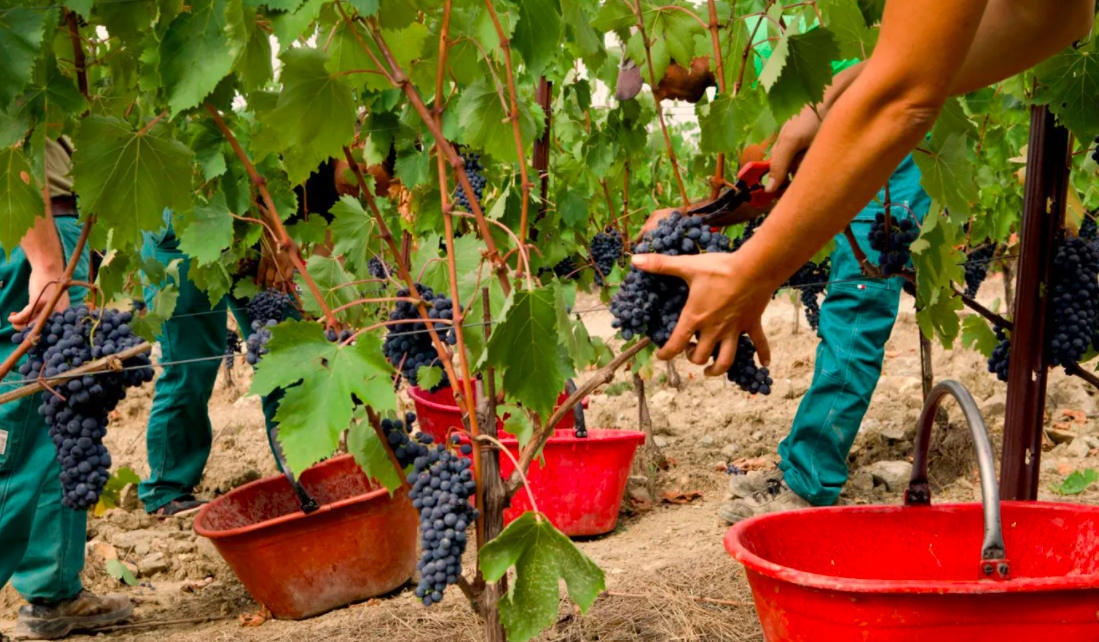 A prized picking – the 2018 harvest at Castello di Fonterutoli
A prized picking – the 2018 harvest at Castello di Fonterutoli
Predicting in 2018 that “the vintage might fall between the opulent 2015s and the structured 2016s in terms of quality and style”, Castello di Fonterutoli’s Giovanni Mazzei underestimated the year. The estate’s 50% Sangiovese and 50% Merlot blend, Siepi, achieves its highest score from Wine Lister’s partner critic, Antonio Galloni in 2018 (97) – five and two points above the 2015 and 2016, respectively. Antonio notes it is “rich, pliant and creamy”, offering “all of the seductiveness of Merlot with the bright acids and grip of Sangiovese”. The 2018 Siepi can be bought from Petersham Cellars for £70 per bottle (in-bond).
Estate Director at Ornellaia and Masseto, Axel Heinz told Wine Lister in 2018 that his “fermenting wines are silky and fragrant”, and that he predicts “a more delicate vintage”. Indeed, Antonio Galloni recently wrote on the 2018 Ornellaia that “readers should expect a silky, aromatic Ornellaia in line with vintages such as 2004 that are more about finesse than raw power”. Having been previewed by members of the fine wine trade and press in a virtual seminar last week (recap our recent blog here), it was awarded a score of 97 by Antonio. The 2018 Ornellaia will be released onto the market at the beginning of April.
Due for release through the Place de Bordeaux in September, Masseto’s 2018 vintage was the first to be made in its own winery, having previously been vinified at Ornellaia. Awarding it 98 points, Antonio notes that it is “silky, mid-weight and supremely gracious”, with notes of “inky red/purplish fruit, cedar, lavender, espresso, sage and mint”. Wine Lister sampled the second release of Masseto’s second wine, 2018 Massetino, in September 2020, and was certainly impressed by its complexity, with expressive notes of dark fruit, cocoa, and spice. While it has limited remaining market availability, it can be purchased from Cru World Wine for £307 per bottle (in-bond).
Describing 2018 as “a good year”, Fattoria Le Pupille’s owner, Elisabetta Geppetti, told Wine Lister that the Bordeaux varietals of her flagship wine, Saffredi, fared particularly well. Antonio Galloni gives it 96+ points, and writes that “the 2018 Saffredi is a regal, elegant, supremely polished wine”, which “may very well be the most refined Saffredi I have ever tasted”. Recalling notes of “sweet red cherry, plum, mocha, licorice and cinnamon”, he concludes; “don’t miss it”. It can be bought from Berry Bros & Rudd for £60 per bottle (in-bond).
Keep track of new Tuscany 2018 scores from Wine Lister partner critics here, and watch this space for future analysis on the vintage.
Last week, Wine Lister joined members of the fine wine trade and press, gathered behind their screens, for the unveiling of Ornellaia’s annual Vendemmia d’Artista collaboration. With each new vintage release, the Ornellaia team chooses a word to characterise the latest growing season and its resulting wine, and selects an artist to bring the word to life on limited-edition labels of the Ornellaia bottle.
Marking the winery’s 13th edition of Vendemmia d’Artista, the 2018 vintage has been coined “La Grazia” – Grace. Estate Director, Axel Heinz, explains that the choice of name is due to 2018 being “a wine that has no hard edges”, and one “all about symmetry, proportion…a graceful expression of Ornellaia”.
Indeed, the higher proportion of Merlot than Cabernet Sauvignon in the latest vintage blend – an exception for the estate – has produced what we found to be a soft and silky wine with a lively perfume and elegant, precise fruit. Ornellaia’s CEO, Giovanni Geddes da Filicaja, notes that the wine really came together “at the time of blending”. He adds, “all the pieces were good, but once we put them all together, it became a really gracious wine”.
That the wine should be so-named came as somewhat of a surprise to Heinz. He reveals that “it was really after the year of ageing and when we sat down in the blending room, that the wine revealed itself to us”. He describes the vintage as “one not without challenges”, expanding thus: “usually [we have] a relatively dry Mediterranean climate. In 2018 we had Mediterranean sun but at the same time enough rainfall to slow the ripening down, and create a wine that is all about balance”.
Belgian artist, Jan Fabre, was chosen to bring La Grazia to life, and limited-edition bottles in various formats will feature his work, as shown in the image below.
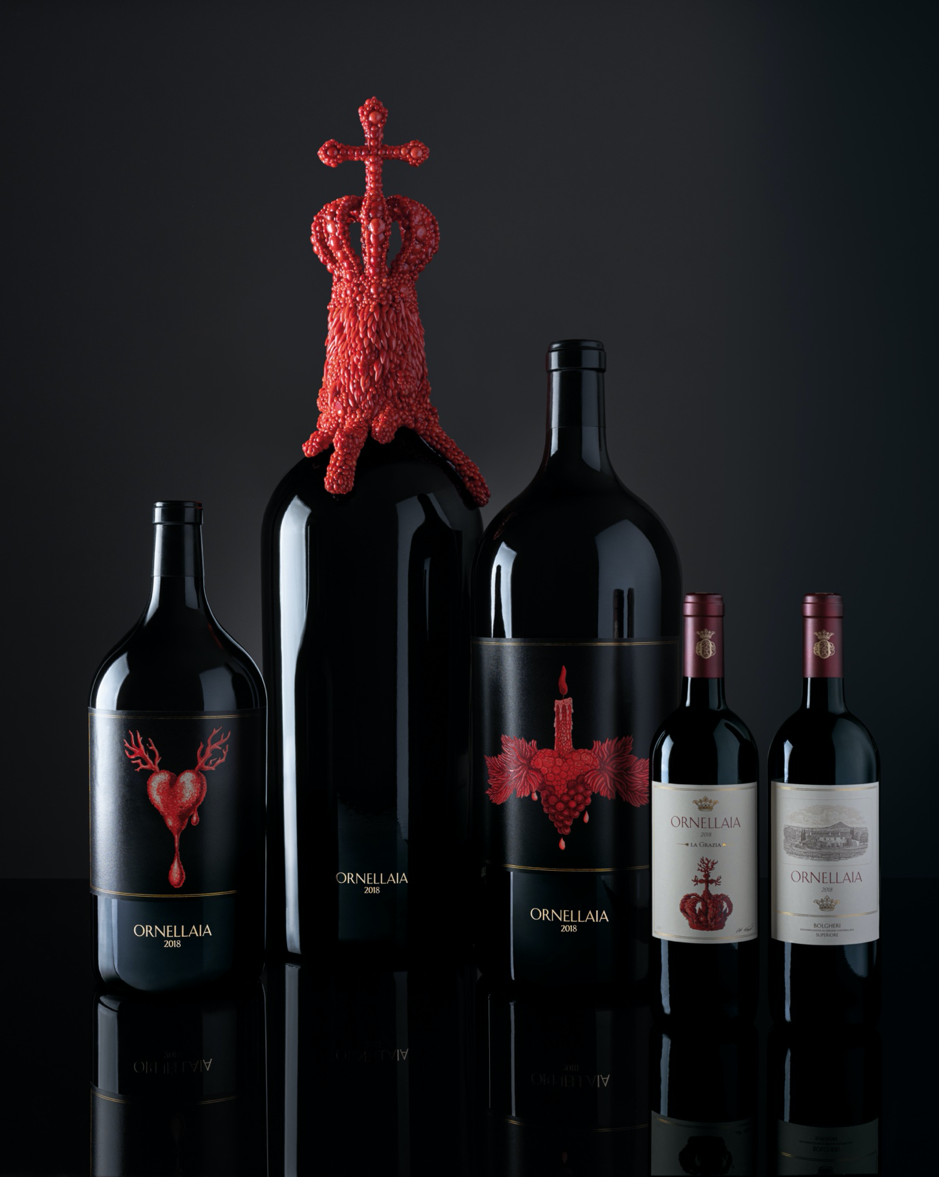 Photo: courtesy of Ornellaia winery – featuring sculpture and drawings by Jan Fabre.
Photo: courtesy of Ornellaia winery – featuring sculpture and drawings by Jan Fabre.
Ornellaia’s art curator, Bartolomeo Pietromarchi, explains the artistic concept as “a way to express balance between beauty and taste”, as well as to “explore the relationship between the senses”. Fabre has sculpted three works from precious red coral, which adorn Salmanazars due for auction in September; “A Candle of Mercy”, “The Crown of Kindness” and “The Heart of Virtue”.
Further bottles feature drawings that bring out the texture of these sculptures – indeed a limited number of 12-bottle cases of Ornellaia 2018 will each contain one bottle with Fabre’s crown label design.
The 111 limited-edition, large-format bottles will be auctioned through Sotheby’s in September 2021, and all proceeds will go towards Ornellaia’s ongoing support of the Mind’s Eye project at the Guggenheim museum.
Wine Lister recently teamed up with 67 Pall Mall for a vertical tasting of five d’Issan vintages led by owner, Emmanuel Cruse, and Commercial Director, Augustin Lacaille. Last Wednesday, Emmanuel transported over 60 members of the UK fine wine trade and press to the historic Margaux property, guiding them through four of his favourite recent vintages: 2000, 2005, 2010, and 2015.
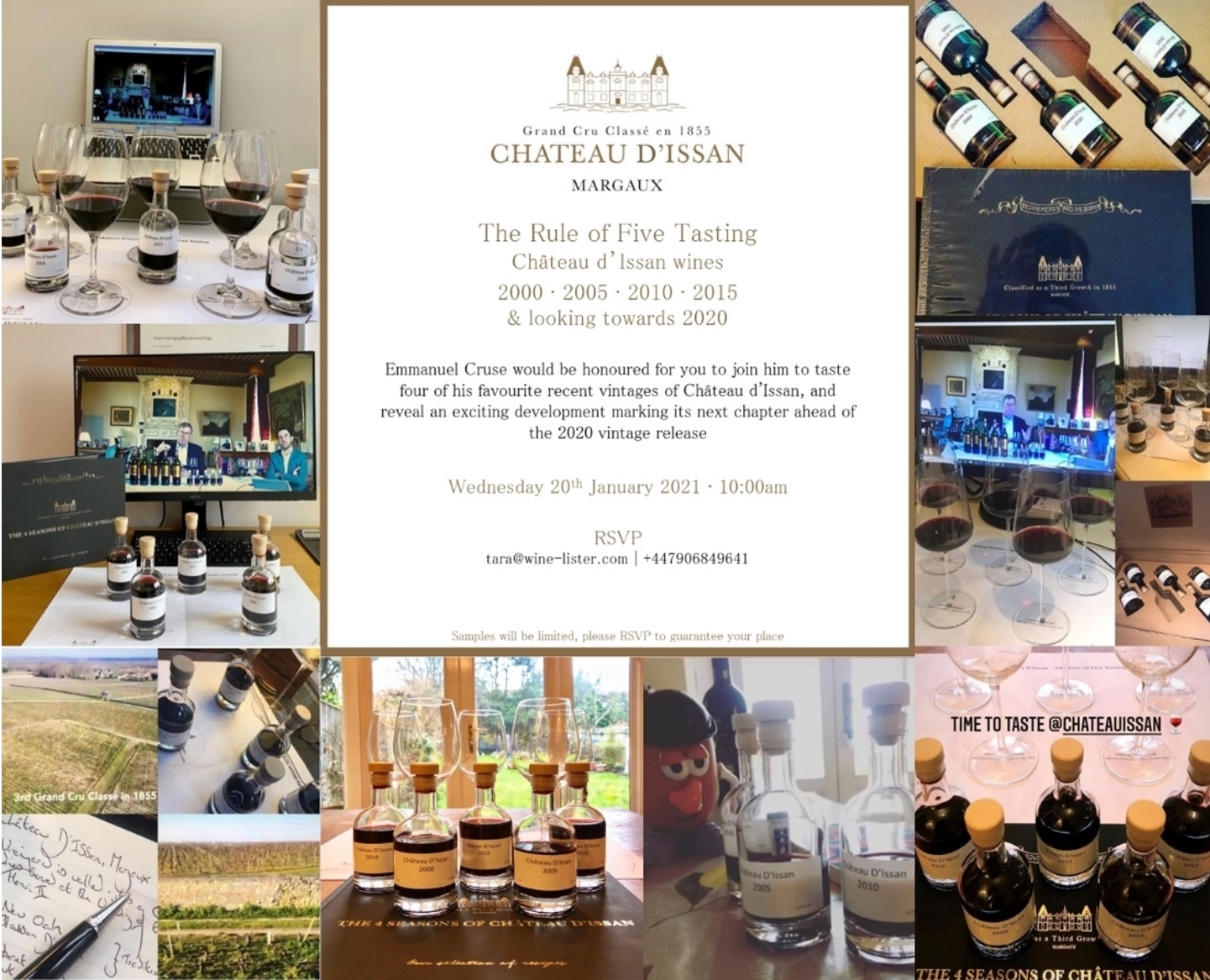 By invitation only: a selection of snaps from guests’ home tasting set-ups. Photos from (from top left anticlockwise): Bud Cuchet (@budcuchet), Charlie Goblet (@charliegoblet), Will Lyons (@mrwill_lyons), Wine Lister (@winelister), Emily O’Hare (@emilyowine), Wine Lister (@winelister), Charlie Goblet (@charliegolet), and Tom Harrow (@winechapuk)
By invitation only: a selection of snaps from guests’ home tasting set-ups. Photos from (from top left anticlockwise): Bud Cuchet (@budcuchet), Charlie Goblet (@charliegoblet), Will Lyons (@mrwill_lyons), Wine Lister (@winelister), Emily O’Hare (@emilyowine), Wine Lister (@winelister), Charlie Goblet (@charliegolet), and Tom Harrow (@winechapuk)
Tasting kits were accompanied by individual copies of The Four Seasons of Château d’Issan – a cookbook assembled by the property’s head chef, Frédéric Braud, with seasonal recipes from a year in the kitchen at d’Issan. Following a short introduction video including aerial scenes of the château and close-ups on its vines, Emmanuel commenced the vertical tasting with the 2000 vintage.
Having taken over as managing director in 1998, he proclaimed that the 2000 was the last “old school” d’Issan. Indeed, the property’s winery has since been almost entirely rebuilt, with a new cellar inaugurated in 2002. The vintage marks the last to be composed of 70% Cabernet Sauvignon and 30% Merlot, the Cabernet proportion being decreased to 60% in 2005.
Emmanuel was not shy in praising the 2005 d’Issan, calling it “the first great vintage” under his watch. He notes there was “perfect weather all year”, recounting how the summer was so warm that the pickers all worked in swimsuits, leading to abnormally regular visits from inquisitive négociants.
According to Emmanuel, 2010 is “from a technical perspective, maybe the best ever vintage made in Bordeaux”. The year had an excellent growing season, void of the hailstorms that had blighted d’Issan in 2008 and 2009. He informed us that the year was also personally special to him, marking the year he married his wife, Virginie. While still on the younger side, Emmanuel suggests decanting the 2010 for three hours ahead of its enjoyment.
The tasting concluded with the 2015 vintages of the property’s Grand Vin and its second wine, Blason d’Issan. Emmanuel stated that it was a broadly excellent year for Bordeaux, and specifically Margaux, which received “less rain than other appellations in the Medoc”. The ratios shifted slightly more towards Cabernet Sauvignon in 2015, which makes up 65% of the blend – Emmanuel’s personal preference.
Hailing from the estate’s younger vines, which are around 15-20 years old, Blason comprises 60% Cabernet Sauvignon in 2015. Emmanuel specifies the same winemaking practices are applied to the second wine, which he hopes to be “an introduction to the flagship”.
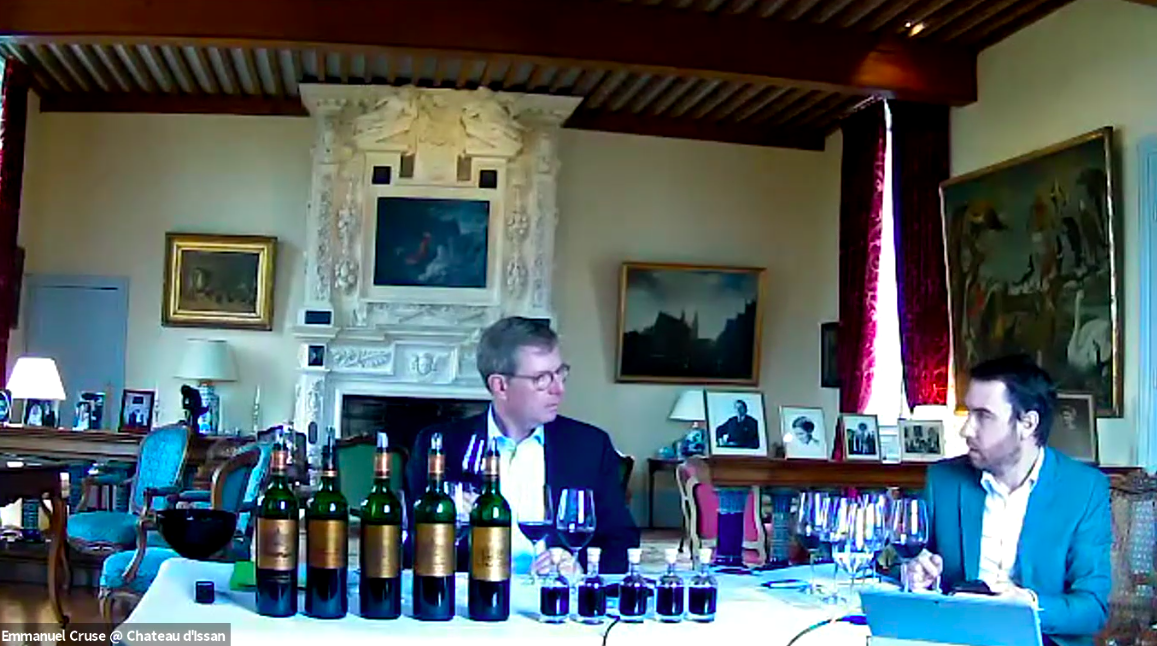 D’Issan owner, Emmanuel Cruse, and Commercial Director, Augustin Lacaille, in “The Rule of Five” virtual tasting
D’Issan owner, Emmanuel Cruse, and Commercial Director, Augustin Lacaille, in “The Rule of Five” virtual tasting
D’Issan 2020 will be released en primeur this year, and we look forward to finding out what the latest edition of “The Rule of Five” will bring – especially since the property’s acquisition of neighbouring Cabernet Franc and Petit Verdot vineyards in March 2020. While the official blend for the 2020 vintage has not been finalised, Emmanuel is sure that the added varietals will be a “real plus”. If the serendipitous pattern of five is anything to go by, especially with the excellent growing season in 2020, the “rule” has every chance of continuing to reign.
For more information on our organisation of virtual tastings and events, please contact the WL PR team here.
The last lot of Burgundy 2019 scores are in, from Wine Lister’s regional specialist critic, Jasper Morris (Inside Burgundy).
Below we explore Jasper’s top scores by Burgundy “subset”, as defined in Wine Lister’s recent study on the region (recap its key findings here).
While no wines earned perfect scores this year, Jasper’s highest score was in fact awarded to a Premier Cru performing beyond its classification – Arnoux-Lachaux’s Vosne-Romanée Aux Reignots. He notes that the wine is “completely heartbreakingly suave and sensational”, offering “crisply ripe cherries, alpine strawberry, the lightest raspberry touch, then a generous pure clear long finish”.
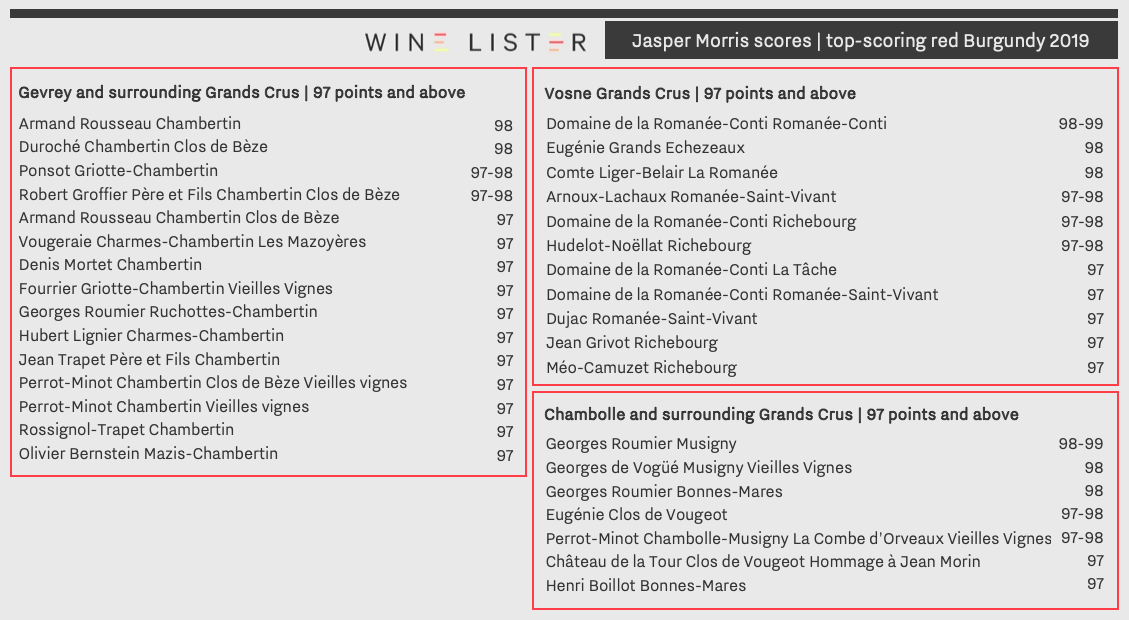
In Gevrey and its surrounding Grands Crus areas, Armand Rousseau fares well, its Chambertin and Chambertin Clos de Bèze earning scores of 98 and 97 respectively. Up-and-comer Domaine Duroché ties for first place within the subset with its Chambertin Clos de Bèze. Jasper describes it as having “a little lick of oak, which is entirely in place, a light, but fresh acidity, a sense of harmony throughout and a deepening of the fruit on the second half of the palate”, creating a “glorious conclusion”.
Georges Roumier proves king of Chambolle and its surrounding Grands Crus, earning two places among the top scorers for the domaine’s Musigny and Bonnes-Mares. Adding testament to the improving quality of maisons de négoce (as mentioned in Wine Lister’s Burgundy study), Maison Henri Boillot makes an appearance among the top ranks for its own Bonnes-Mares.
Domaine de la Romanée-Conti understandably dominates the Vosne Grands Crus category, though star producer Arnoux-Lachaux features among the top 11, in addition to its high-scoring Vosne-Romanée Premiers Crus. Speaking to Wine Lister following the completion of his Burgundy 2019 reports, Jasper notes that Arnoux-Lachaux has “unequivocally joined the greats with a faultless array of stunning wines in 2019, hitting heights of ethereal elegance without sacrificing power”.
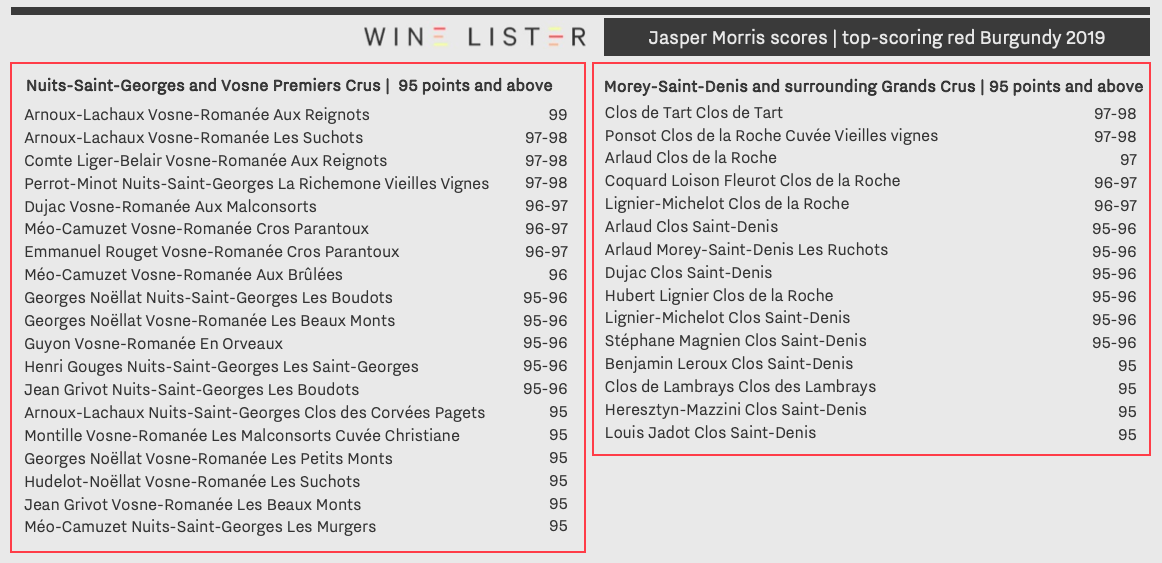
Jasper reports that Morey-Saint-Denis has done well in 2019, as “the village which had the benefit of the best rainfall figures in August”. He adds, “not only are Clos des Lambrays and Clos de Tart progressing well under their new ownerships and winemakers, but class acts such as Domaine Dujac and Christophe Perrot-Minot have filled their boots, while Domaine Arlaud have produced their best set of wines ever”.
Interestingly, no Côte de Beaune red scores above 96 from Jasper in 2019 (though the top scorer at 95-96 points is Méo-Camuzet’s Corton Rognet). See all top scores for Côte de Beaune reds in 2019 here.
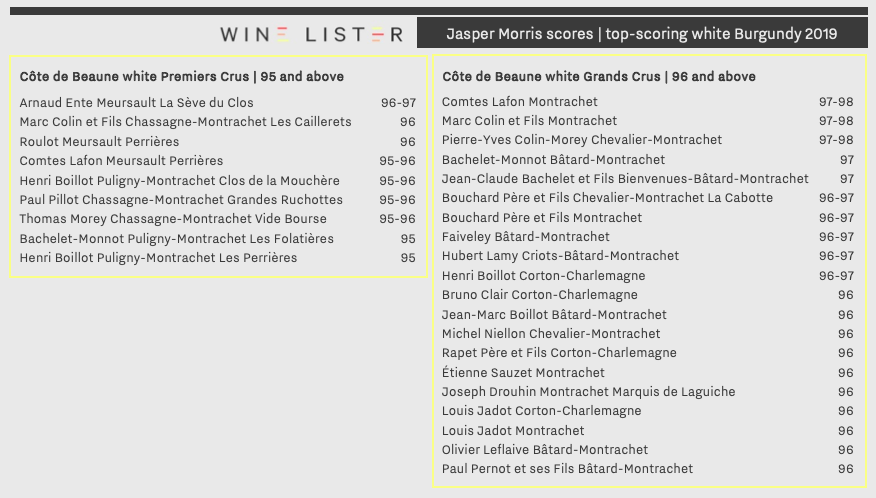
Whites in 2019 do not reach the dizzy score heights of their red counterparts. The above chart therefore takes into account Côte de Beaune white Premiers Crus with scores above 95, and Côte de Beaune Grands Crus achieving 96 points or above.
In the latter subset, maisons de négoce Bouchard Père et Fils and Maison Jadot achieve two entries apiece, for their Chevalier-Montrachet La Cabotte and Montrachet, and Corton-Charlemagne and Montrachet respectively.
Producers Bachelet-Monnot, Comtes Lafon, Domaine Henri Boillot, and Marc Colin also all appear twice in the top Côte de Beaune white rankings for 2019.
View more Burgundy 2019 scores here. Wine Lister Pro users can search and filter by critic scores, and can view all of Jasper Morris’ top Burgundy 2019 scores here. Click here to find out more about the Pro subscription.
The majority of Burgundy 2019 en primeur scores have now been published by another Wine Lister partner critic, Neal Martin (Vinous), offering further insight into the best bottles from the latest vintage.
Explore all Burgundy 2019 WL scores here, or read more below.
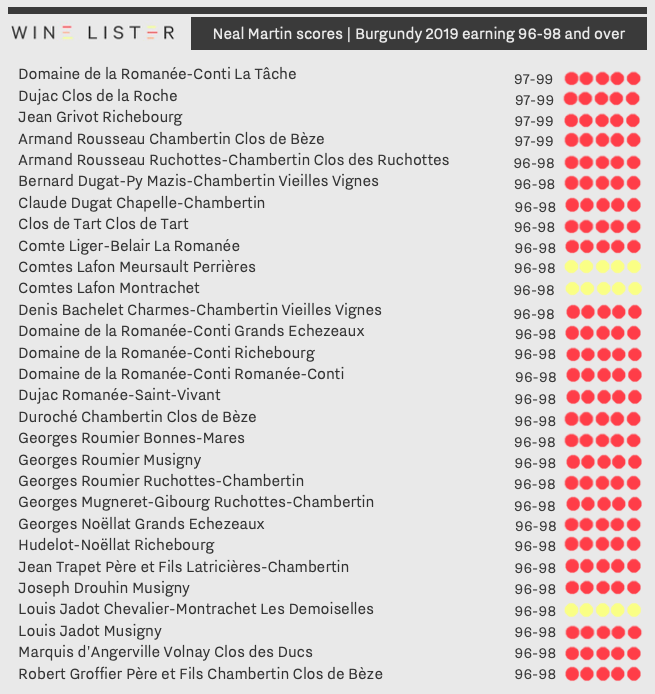
While no wines earned perfect scores this year, fittingly there are 19 Burgundy 2019s that earn 96-98 and above (compared to 15 in 2018). Domaine de la Romanée-Conti La Tâche, Dujac Clos de la Roche, Jean Grivot Richebourg, and Armand Rousseau Chambertin Clos de Bèze fare notably well with scores of 97-99.
Domaine de la Romanée-Conti occupies a further three places on the list, with its Grands Echezeaux, Richebourg, and Romanée-Conti, compared to two Domaine de la Romanée-Conti wines that appear in this score bracket in 2018.
Also scored generously by Jancis Robinson this year (recap our recent examination of her Burgundy 2019 here), Georges Roumier is awarded 96-98 for his Bonnes-Mares, Musigny, and Ruchottes-Chambertin. Featuring on both critics’ list of top-rated wines from the vintage, the Musigny is described by Neal Martin as “beautifully defined on the nose”, offering “a mixture of red and black fruit laced with blood orange, it fans out wonderfully toward the finish”.
The only white Burgundy to gain a score of 18.5 from Jancis Robinson so far, Comtes Lafon’s 2019 Montrachet is one of three whites awarded 96-98 by Neal Martin, alongside its Meursault Perrières and Louis Jadot’s Chevalier Montrachet Les Demoiselles. Members of the Wine Lister team sampled the latter at Louis Jadot’s 2019 en primeur tasting in November 2020 (recap here), and were also impressed, detecting notes of honey and brioche to complement its defined acidity.
Also featured on the list of Burgundy 2019s earning 96-96 and over from Neal Martin are: Armand Rousseau Ruchottes-Chambertin Clos des Ruchottes, Bernard Dugat-Py Mazis Chambertin Vieilles Vignes, Claude Dugat Chapelle-Chambertin, Clos de Tart Clos de Tart, Comte Liger-Belair La Romanée, Denis Bachelet Charmes-Chambertin Vieilles Vignes, Dujac Romanée-Saint-Vivant, Duroché Chambertin Clos de Bèze, Georges Mugneret-Gibourg Ruchottes-Chambertin, Georges Noëllat Grands Echezeaux, Hudelot-Noëllat Richebourg, Jean Trapet Père et Fils Latricières-Chambertin, Joseph Drouhin Musigny, Marquis d’Angerville Volnay Clos des Ducs, and Robert Groffier Père et Fils Chambertin Clos de Bèze.
Though Wine Lister are missing what would have been London’s Bourgogne tasting week this week, our partner critic, Jancis Robinson, has now released the majority of her scores for the 2019 vintage, providing a better picture of the top en primeur picks.
Explore all Burgundy 2019 scores here, or read more below.
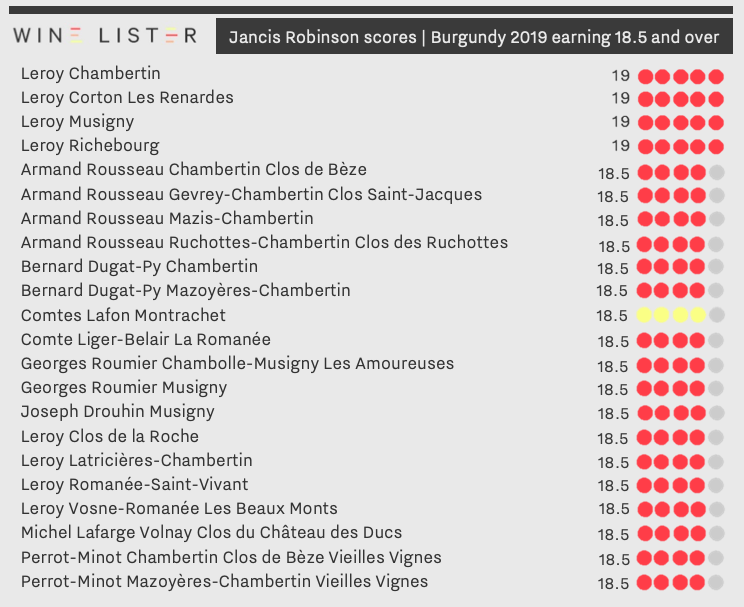
A drought year resulting in wines of extreme concentration, yet balanced by energising acidity (recap Wine Lister’s report on Burgundy’s 2019 vintage here), there are 22 Burgundy 2019s that have so far been given a score of 18.5 or above.
Jancis awarded 19 points to Leroy’s Chambertin, Corton Les Renardes, Musigny, and Richebourg, after having not published any scores for Leroy since the 2013 vintage. The property fares extremely well in 2019, occupying eight places in the list of 22 wines earning 18.5 and over. Leroy’s Clos de la Roche, Latricières-Chambertin, Romanée-Saint-Vivant, and Vosne Romanéee Les Beaux Monts all achieve a score of 18.5.
Armand Rousseau occupies four places in the list, with its Chambertin Clos de Bèze, Gevrey-Chambertin Clos Saint-Jacques, Mazis-Chambertin, and Ruchottes-Chambertin Clos des Ruchottes all earning 18.5 points. While slightly down on her ratings for the property’s 2018 offerings (she awarded 19 points to Rousseau’s Clos de la Roche and Ruchottes-Chambertin Clos des Ruchottes in 2018, and a further 18.5 points to its Chambertin, Chambertin Clos de Bèze, and Gevrey-Chambertin Clos Saint-Jacques), it nonetheless continues its excellent quality performance in 2019.
Comtes Lafon’s 2019 Montrachet is the only white Burgundy to gain a score of 18.5 from Jancis Robinson so far, continuing its series of top scores awarded by the critic in recent years. She describes it as “Both rich and savoury. Not remotely fat but with massive intensity. Throbbing and jewel-like”, concluding that “Dominique [Lafon] must be thrilled by this”.
Also featured on the list of Burgundy 2019s earning 18.5 and over from Wine Lister partner critic, Jancis Robinson are: Bernard Dugat-Py Chambertin, Bernard Dugat-Py Mazoyères-Chambertin, Comte Liger-Belair La Romanée, Georges (or Christophe) Roumier Chambolle-Musigny Les Amoureuses, Georges (or Christophe) Roumier Musigny, Joseph Drouhin Musigny, Michel Lafarge Volnay Clos du Château des Ducs, Perrot-Minot Chambertin Clos de Bèze Vieilles Vignes, and Perrot-Minot Mazoyères-Chambertin Vieilles Vignes.
View more Burgundy 2019 scores (including those of Jasper Morris and Neal Martin) here.




 Official photos courtesy of Tenuta San Guido
Official photos courtesy of Tenuta San Guido







